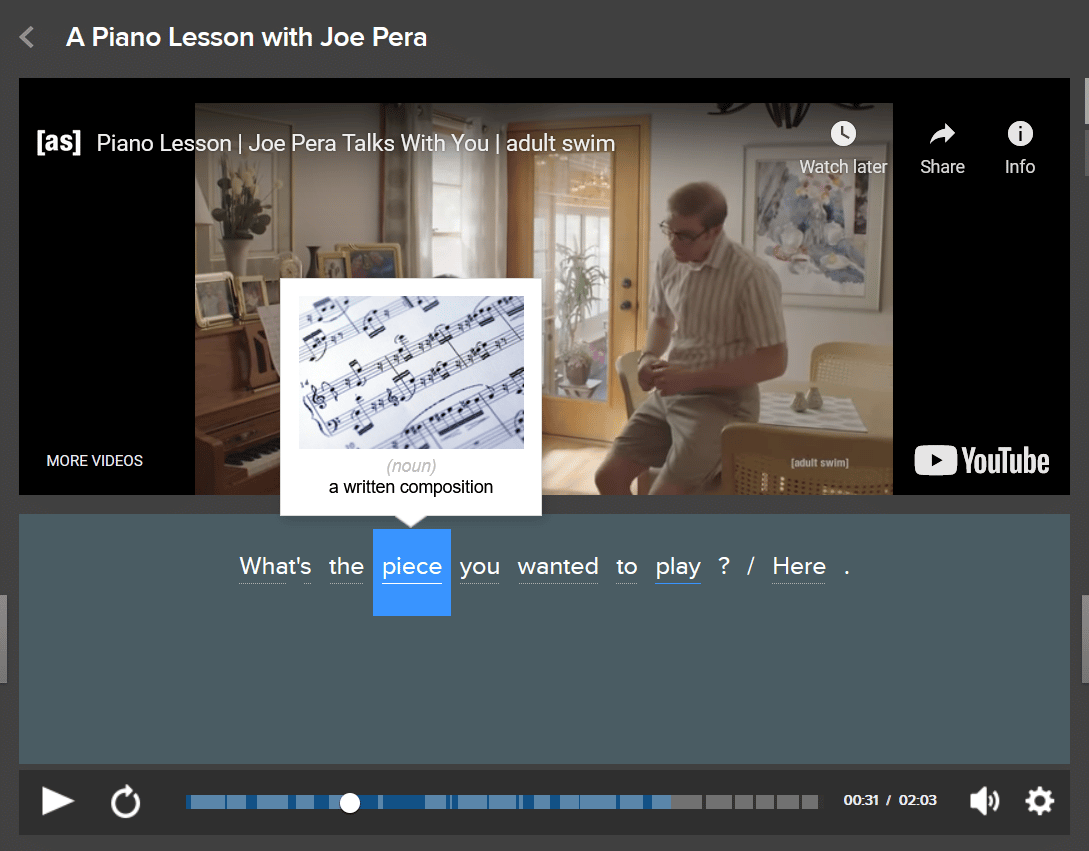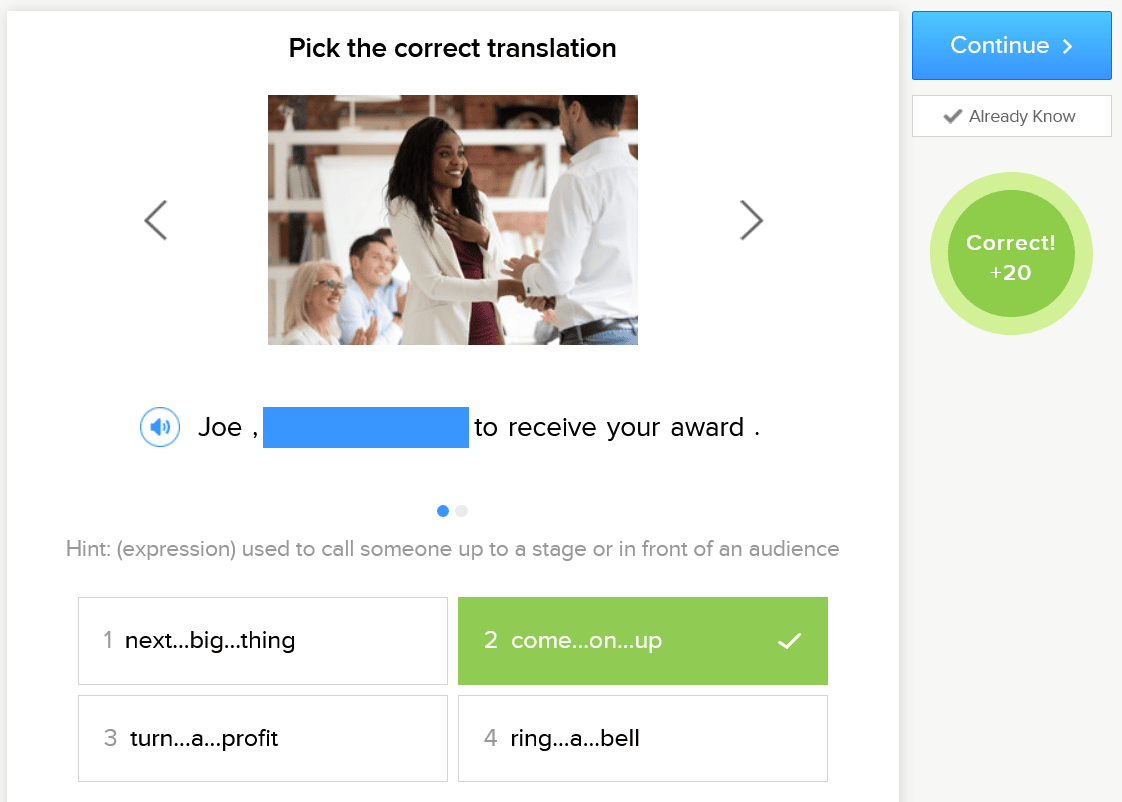Easy Video Clips to Work on in English Classes

7 Excellent ESL Video Activities: Lessons and Clips Students Will Love
There's never been a better time to use video in the ESL classroom.
Remember the old days of VCRs, VHS tapes and trips to Blockbuster?
When I started teaching, my classroom video materials were well-worn, borrowed cassette tapes or ones I recorded at home.
Finding a good quality video was like striking pure, untarnished gold.
Once you'd acquired the precious item, you'd need to find a room, set up a TV, plug in the video player and then hope to goodness that everything worked.
Sometimes, you'd accidentally stick a VHS tape in a Betamax machine (yes, I'm that old!) and ruin everything.
To be honest, it was such a hassle that you just didn't bother most of the time.
Fast forward a few years, (sorry about the pun!) and video is all around us—it positively defines our cultures and lifestyles. The language teacher's best friend, the Internet, has tremendous resources available.
Download: This blog post is available as a convenient and portable PDF that you can take anywhere. Click here to get a copy. (Download)
Where to Find ESL Videos Online
The breadth of videos suitable for ESL education is vast, but some sources that host them are more reliable and consistent than others. Here are a few great options that you should check out:
YouTube

Being the biggest online video platform in the world, YouTube unsurprisingly hosts an abundance of material that can either be formatted specifically for education or have the potential to be educational. "Lack of content" will never be an issue with YouTube, and it's quite likely that YouTube will be one of your main resources.
You can pull up anything, from a lecture-style video made by a fellow ESL instructor, to a more mainstream clip that you can re-purpose as a learning tool while impressing your students with your culture savviness.
While quantity is certainly no problem with YouTube as an ESL video source, quality might be a bit more questionable. With YouTube, if you're not going to go straight for educational content and want to use more entertaining clips, you'll have to personally filter through the vast depths of your searches to find usable videos.
Because videos are not always moderated, some clips titled to be English-teaching material may turn out to be not so learner-friendly (in more ways than one) and you'll have to check for yourself that the content is both reliable and accurate.
There's also the issue that YouTube videos don't always offer learner features. Subtitles and closed captions are nice, but they're not always 100% correct. You can slow down the video, but the speech becomes warbled and distorted. For your teaching purposes, you can still utilize what YouTube has to offer in terms of entertainment and variety; even if they lack learner features, YouTube videos may have a high chance at eliciting engagement and interest from your students, particularly if they're into the social media scene.
FluentU

If you're looking for a video resource that basically handles most of the heavy-duty work for you, then FluentU is a fantastic choice.
FluentU for English learners creates a special educational experience created by utilizing real-world media—that is, the kind of videos and clips that native speakers would watch. This guarantees that not only will students be treated to authentic content that they'd surely appreciate, but they'll also be exposed to the English that they should expect to encounter and even the English used in different contexts.

Furthermore, you can choose from the plethora of available options without worrying about how you can make any of them learner-friendly—all of FluentU's videos (which are labeled by learner level and topic) are supplied with interactive subtitles and transcripts, vocabulary lists and context-dependent definitions for words.
There are even short quizzes provided that you can use as post-viewing reviews. With all these learner features in your control, you can make ESL video learning in the classroom smooth and seamless, which means you can commit the necessary time and effort to the video activities you plan.

FluentU can take a huge load off any ESL instructor's shoulders by doing a lot of the prep work involved in finding appropriate ESL videos. FluentU's videos meet all the necessary criteria: they're diverse in content, relevant to current culture and friendly to learners.
Voice of America

While it outwardly appears as a news website, Voice of America actually also offers specialized ESL lessons for interested learners. These lessons appear in compilations: the 52-week "Let's Learn English" class helps students to learn the fundamentals of English language and bits of culture and the "Everyday Grammar TV" is specialized to teach grammatical concepts. There are also a number of short clips to teach idioms.
What's great is that you can use the main face of the website as a great supplement to English learning. You can combine VOA's coverage of a wide variety of news and cultural topics with English education to make a more engaging and world-relevant learning experience for students. This can be great for sparking discussion on current events and enable students to use specific English terminology fitting the discussed topic.
It might be a little hard to navigate through the website, since there's so much content and much of it is related to news, though you may find this a boon especially if you want to incorporate social studies into your lessons. Also, while you're scouring the site to find a suitable video, it's possible that something might catch your eye that you can add on the spot as a supplement to your planned lesson. Nothing like a bit of improv to spice up class time!
engVid

engVid is a great source for videos that are tailored for classroom use. The relatively short videos cover many aspects of the English language and are easily digestible for learners of all levels. There are even videos tailored for more specific topics, such as test prep for standardized English exams, tips for interviews and even a brief overview of some accents.
The accessibility of the videos is enhanced by the friendly and casual natures of the instructors themselves, who often try to speak about the topics in a current and up-to-date way so that the information is relevant. If you'd like students to use the resource for their own personal use, they have the option to approach the instructors with questions to get specific answers.
The videos are usually instruction-like and explanatory, but this plus the variety of topics that engVid covers can offer a lot of opportunities for you to further explain different concepts, perhaps in ways that encourage interaction among your students (such as skit performances). Combining technical instruction with more engaging or creative practice will certainly enhance the students' absorption of the material.
Why Teach ESL Students with Videos?
There are a number of reasons why video is a great resource in the ESL classroom:
- It's fun and adds a change of pace the students will appreciate
- It's great for visual learners
- Videos bring your subjects to life
- Videos teach students how to speak naturally
- The language is used in a realistic, real-world context
- Students are exposed to natural pronunciation, stress and intonation
- Depending on what's shown, video can even make a lesson memorable
- Showing a small clip can be just as effective as playing a whole movie
- And best of all, videos can be a great way to let students practice a wide variety of language skills
Ideal Types of Videos for ESL Instruction
Video-based material can range from a still picture taken from a video to the whole movie or TV show and everything in-between. Which one you choose depends on the aim of the lesson at hand.
1. Documentaries
2. TV shows, films and trailers
3. Cartoons
4. Homemade videos (including the students' own home videos)
5. Advertisement
6. News clips and stories
7. Weather forecasts
8. Instructional videos (focusing on English language acquisition or other content areas)
9. Vlogs and video clips from websites
10. Sports events
Now that we've got that out of the way, ready to learn how to use videos seamlessly in your ESL lessons? Read on to find out!
How to Use Videos in the ESL Classroom
With a good idea of what kinds of videos you can use and where you can find them, now you must learn the art of using said videos in the classroom itself. Here are a few quick tips to keep in mind so that your and your students' experiences are as educational and engaging as a video class session should be!
1. There's a right time and place for certain videos
Make sure that the videos you choose aren't offensive to your students, especially when it comes to matters of culture. To find out what constitutes a potentially offensive or uncomfortable topic, consider doing some research or reaching out to a fellow teacher to ask about your lesson plan. For other matters of offense, common sense will likely be your first guide; for example, it might be hard to have a productive educational experience with a video filled with English expletives.
On the other hand, you can also spike student interest with videos addressing aspects of English culture and politics, particularly aspects that would be unfamiliar to non-native English learners. You can then transform that interest into engagement and start some lively conversations with your students while promoting their use of English at the same time.
The productivity can be amplified especially if the video goes into current and relevant events, since students can then be more encouraged to express their own opinions and thoughts.
2. Find videos that are "just right" in length
One of the trickier things to figure out when using videos is determining how much of the class session they should take up.
Videos that are too short usually don't offer much in terms of content that you or your students can bounce off of, which ultimately makes them unhelpful. Videos that are too long can drag on and pull your students' interest with them, at the same time making it harder for you to figure out which piece of the dense clip you should use for targeted learning.
Try to generally aim for videos that are about two to 10 minutes long. Two minutes usually allows for a single topic to be explored with enough depth for you to work with, while 10 minutes is enough to have grabbed learners' attention and enable back-and-forth conversation discussing what was viewed.
Some ESL instructors would use an entire film to fill up the classroom time, and this can be a great thing if done right! Just make sure that the film uses a level of English that overall matches your learners' level, and has content that utilizes topics and lessons that were recently covered.
3. Make sure that the students can follow along
Pick videos that have good-quality audio and English speech of reasonable pace that the students can readily follow. You may find a clip that may be incredibly entertaining and is certain to perk your classroom up, but if the audio isn't accommodating to what your students need, then you should find an alternative.
Also, make sure that you turn up the volume and pause or slow down the video as needed!
4. Dissect the videos' content and make personal connections
Asking basic comprehension questions after students watch a video is a good practice to test their understanding, but try and go beyond asking students what they've just seen or heard.
Instead, explore the content more deeply and feel free to ask more open-ended, thematic questions. Pull apart ideas that may not be explicitly shown in the clip but can be applicable to the content, so that discussion can become more interesting and nuanced. For example, if you use a video that teaches common slang, you can go into the actual etymology and origins of the words to see where they came from and how they perhaps came to be.
Making personal connections with learning content is also a very powerful way to ingrain material. When you use videos that discuss more cultural or social matters in English, encourage your students to think of and express their own perspectives on these topics. Even with videos that discuss technical matters of the language, you can still ask students how things work in their first language to help them better remember any differences in word order, grammar and the like.
5. Create targeted challenges during viewing
While videos in classrooms often work well to keep students interested, sometimes they can do the opposite due to the general lack of an instructor's input during the viewing. It's quite easy for students to either phase out or snooze away. Other times, a video can become distracting with its visuals in a way that won't help even your visual learners!
In order to avoid those issues, try to set specified challenges for students to do while they're watching. For example, you can ask them to take note of what adjectives were used, how many declarative sentences were spoken and so forth. By doing this, you encourage active listening and attention, two things that can be lost quickly with less engaging or longer videos.
Now we can get on with the fun part—the different kinds of activities you can plan for your students so that they'll be eager and expectant the next time you pull up the screen during class!
7 Excellent ESL Video Activities: Lessons and Clips Students Will Love
There are almost as many ways to exploit video material as there are videos. Here are just seven ideas to get the ball rolling in the right direction.
1. What Happens Next?
Aim: To practice speculating and predicting, initiate authentic discussion and generate interest in a topic.
Material: A video with some kind of cliffhanger, like a trailer for a TV show or movie. Try this trailer for "The Good Place!"
Procedure: Set up the situation. Teach any necessary vocabulary beforehand. Play the video and stop at a suitably exciting place. Have students discuss in pairs or groups what they think happens next. Elicit responses and write them down on the board. Play the rest of the video to see if they were right.
2. What Are They Like?
Aim: To practice describing people and use language of speculation (could be, looks like, seems like, etc.)
Material: A short clip or still which clearly shows one person (and key details such as age, clothes, features, mannerisms or voice). This could be someone in a TV interview, a character in a film and so on. Try this video of Jimmy Fallon interviewing Post Malone. They'll have a lot of fun describing someone like Post Malone!
Procedure: Review descriptive language, and then review or teach expressions of speculation before starting this activity. Play a short clip and get students to ask and answer questions about the character, including: age, job, personality, kind/unkind, intelligent/unintelligent, what hobbies they have, married/single and areas of expertise.
To elicit further discussion, they can argue their points in groups justifying their opinions. For example, one student may get up and explain that "he looks like a lawyer because…" and go on to enumerate his lawyer-like qualities.
3. What Are They Talking About?
Aim: To practice language of opinion and speculation, show the importance of body language and generate interest in a topic or story.
Material: A short clip of two characters talking. You could show them this video of Rachel telling Ross she's pregnant on "Friends."
Procedure: Explain the activity. Discuss the importance of body language in communication. Review or introduce vocabulary and expressions of opinion and speculation. Play the clip with the sound muted. In pairs or groups, have students speculate on the moods, perspectives and relationships of the characters from their body language clues. See if anyone can figure out what the characters are actually discussing.
Give feedback and then play the clip with the sound turned up. You could have further discussion on the importance of body language in language learning or in different cultures.
4. Video Jigsaw
Aim: To practice telling a story, giving descriptions (scene, characters) and practicing language of speculation and decision making.
Material: For this one you'll need a clip of a movie, TV show, advert or other video with a strong storyline (having a distinctive beginning, middle and end sequences). This has to be divided into three (or more) parts. Each group will be watching a different part. You'll also need access to separate computers or TVs in different rooms. If this isn't possible, then one group can watch the film in a corner of the room while the other two groups work on a related task—then they'll all swap around until each of the three groups have watched their clip.
Procedure: Put students in three (or more) groups, labeled A, B and C. Each group watches their clip from the video, which should be a different part of the clip. They discuss what they've seen and then form new groups made from one person from each of the original groups (grouped together like: ABC, ABC, ABC). They retell their part of the film to the others in their new groups. Then, each group tries to work out the correct order and the complete story.
They then watch the complete film to check if they were right.
5. Phonology Focus
Aim: To draw attention to the importance of the shape and position of the jaw and mouth muscles in the target language. To highlight the rhythm, stress and intonation of the language.
Material: Choose a video clip where there's a close up of someone talking for at least 20 seconds.
Procedure: Introduce the topic—the idea of the "music" of a language and also what happens to the faces of people speaking different languages. Play the video with the sound muted, pointing out the mouth and jaw muscles they're using. Note the shapes of their mouths, positions of lips and so on.
Get students to imitate this, making it fun. Now play the clip with the sound quite low so they can focus on the rhythm, stress and intonation of the language. Get them to repeat sections, trying to mimic the speaker as best they can without using the words, just the sounds. This will kind of sound like, "bla bla BLA," or "da da DA da da da." Again, this focuses attention away from the words and towards the music of the language.
Finally, if necessary, hand out copies of the script and get the students to repeat the actual words while trying as much as they can to retain the "music."
6. Memory Test
Aim: To practice listening for meaning and to practice role-play and improvisation.
Material: A clip with a short dialogue between two characters.
Procedure: Students work in pairs, A and B. Tell them that you're going to play a short clip and Student A must remember what one character said. Student B must focus on the other character and remember what theysaid. Play the clip once, or more times as necessary.
They can then re-enact the scene and check for accuracy with the original at the end. Try to keep this activity light and make it fun. If they can't remember, improvise!
7. Which Film?
Aim: To practice giving opinions, agreeing and disagreeing. Persuasion.
Material: Several movie trailers. Try vastly different movies, such as "13 Going on 30," "The Fast and the Furious" and "Good Will Hunting."
Procedure: Set up the task, teaching language and vocab as necessary. Tell them they're going to watch a movie, but there's only time for one. Let them know that in order to watch even that one, they must all agree on which one they want to watch—as a group. Play trailers from several films. Then, put the titles on the board.
Put the students in groups and let the discussion commence! Try to get each group to agree on watching the same movie. Provide feedback to the whole class. If possible, play the whole movie or go and see it together as a class.
Videos are awesome as teaching and learning tools, and I think you'll agree once you see them in action in your classroom.
As well as providing great examples of language structure and function in context, they're a wonderful way to teach vocabulary. Video is also a great tool for encouraging discussion and bringing a light-hearted approach to sometimes tricky areas like pronunciation, stress and intonation. I hope you've found some ideas here you that can use with your own classes. Good luck, and happy watching!
Download: This blog post is available as a convenient and portable PDF that you can take anywhere. Click here to get a copy. (Download)
bullardsymaine1985.blogspot.com
Source: https://www.fluentu.com/blog/educator-english/esl-video-activities-lessons-clips/
0 Response to "Easy Video Clips to Work on in English Classes"
แสดงความคิดเห็น